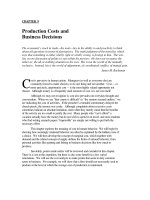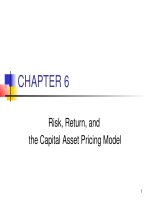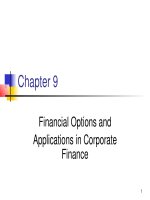Lecture Managerial economics - Chapter 3: Production, costs and supply
Bạn đang xem bản rút gọn của tài liệu. Xem và tải ngay bản đầy đủ của tài liệu tại đây (996.46 KB, 22 trang )
PRODUCTION, COSTS AND SUPPLY
Inputs, Outputs, and Decisions
TYPICAL ORGANIZATION CHART OF A FIRM
PRODUCTION
Production
is the act of transforming
resources into goods and services that are
more valuable.
For example, oil is extracted from the
ground, refined into gasoline, and used as
transportation fuel.
A hair stylist uses time, scissors, and
chemicals to make a customer feel more
attractive and self-confident, which is
potentially of great value for a job interview.
OUTPUTS, INPUTS, AND BUSINESS FIRMS
A
firm is an entity combines inputs to
produce output.
A firm’s production function is the
relationship between it’s inputs and output.
OUTPUTS, INPUTS, AND BUSINESS FIRMS
For
every bundle of inputs the production
function shows the maximum output that can be
produced.
Here we assume that all inputs are the same
within their classification; i.e., all labor is
homogeneous
We also assume one person that makes all
decisions on inputs and outputs and is the
residual claimant (pockets the profits).
There are no conflicts in this hypothetical world.
ECONOMIC COST CONCEPT
Opportunity cost: next best alternative use
• The real cost is what you give up to get it
• In economics, all the costs are measured by
opportunity cost.
• Opportunity cost includes explicit and
implicit costs–includes time value of
searching/waiting
Example:
opportunity cost might even help
explain why higher earners spend less time
asleep on average than those who make less.
TWO TYPES OF MANAGEMENT PROBLEMS
Decision Making
• Which product should we be producing?
cost
• How should we price our products? Opportunity
matters
• What strategy should we be pursuing?
• Should we be in this business?
Control
• Are our managers performing well? Accounting cost
matters
• Are our businesses performing well?
• How can we influence the behavior of our
people?
COST STRUCTURE
Economic Cost Structure (Opportunity
Costs)
• Fixed Cost: Costs that do not vary with quantity produced
• Variable Cost: Cost that do vary with quantity
• Sunk Cost: Costs that cannot be avoided regardless of action
Accounting Cost Structure (COGS)
• Direct Cost: Labor and Materials
• Indirect Cost: Overhead Cost
– accountants sometimes call this as “fixed cost”, which is not
fixed cost in economics
» some overhead cost does vary with quantity (“avoidable”),
NOT fixed.
» Ex. Production supplies, tools, benefits vary with quantity
In general, Accounting cost ≠ Economic
cost
MANAGERIAL ACCOUNTING
For decision making problems, opportunity cost
matters.
• But often in practice, opportunity costs are not
given.
• Instead, you need to make business decisions
based on financial statement which shows
accounting costs.
How to translate the accounting cost into
opportunity cost?
Course of Managerial Accounting
QUESTION: FIXED OR SUNK?
Fixed cost
• A past expenditure that can be recovered by
reselling
–ex: cost of equipment that may be recouped by
equipment sale
Sunk cost
• A past expenditure that cannot be recovered
–R&D investment in pharmaceutical companies
•Principle: Let bygone be bygone
• Sunk costs “should not” influence an individual’s or
firm’s decisions.
–Why?
DISCUSSION
You bought a theater ticket for $15 a few weeks
ago.
Bad news:
• At the theater you find you left the ticket at
your home and it’s too late to go back.
Good news:
• But you can still buy a comparable ticket for
$15 at the box office
Q: Will you buy a new ticket & see the show?
Q: Which is the rational decision?
IS SUNK COST BAD FOR THE BUSINESS?
Suppose you are running a business and found
that you incurred a huge sunk cost in the
previous quarter.
Q: Is this good or bad for your company?
SUNK, FIXED, VARIABLE COST
Discuss the cost structure for the following
industries
1. Computer Industry
2. Software Industry
3. Pizza Industry
SUMMARY
1. Principle: The real cost is what you give up to
get it.
• Economic cost is the opportunity cost
2. Opportunity cost matters for decision making,
accounting cost matters for control purpose.
3. Principle: Let bygone be bygone
• Don’t consider the sunk cost when making
decision
SUPPLY CURVE
SUPPLY CURVE
1. Supply curve = Marginal Cost curve
2. When does the supply curve shift?
3. Producer Surplus
SUPPLY CURVE = MARGINAL COST CURVE
• In a competitive market, where you can’t change
the price
Supply curve = (Marginal) cost curve
Implications?
• If anything happens to the cost, the supply
curve changes (shifts)
SUPPLY CURVE SHAPE
Q: COST INCREASE = PRICE INCREASE?
SUPPLY CURVE “SHIFTERS”
IMPACTS ON SUPPLY ARISING FROM CHANGES IN SUPPLY
DETERMINANTS
PRODUCER SURPLUS
SUMMARY
1. Marginal cost curve is supply curve.
2. Supply curve shifters: Change in cost









